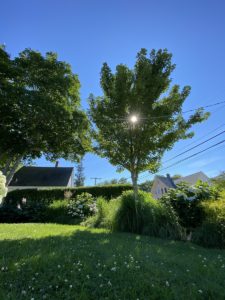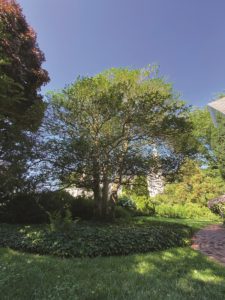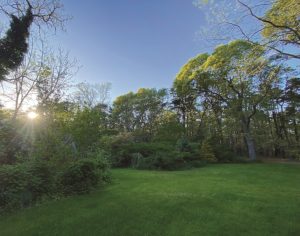Take a moment and let yourself drift back to a memory. Can you recall a place where, long ago, you took shelter in the shade on a sunny day — a safe space where you felt still and held? Often central to this kind of memory there is the benevolent presence of a tree, standing anchored and steadfast.

Trees hold a central, significant space in our gardens and landscapes, just as they do in our stories and memories. They shape our experience, just as they shape the garden itself. Here is a place where a family sets up a table for dinner on a summer night. Where books are read, naps taken, pets buried. A place of first kisses and of last goodbyes.
Trees affect us throughout our lives. There is a great deal of research indicating a correlation between the presence of trees, and even just the sight of trees, and an increased sense of calm, improved and faster healing, and an overall sense of well-being. Trees represent safety and possibility in our ancient lizard brains. We feel this in our cells.
Trees are one of the most influential design elements in a garden, both visually and environmentally. They provide structure, hold and create enormous space, and shape the feelings we are likely to encounter beneath them. They provide a focal point, something our attention can be rooted in. The space under and within their canopies gives a sense of containment, a sensation that tends to comfort our minds. Trees stand over us, wise and patient; they are the grandmothers and grandfathers of the garden.

If we think of our gardens as spaces and rooms, trees are the pillars and ceilings. A massive old tree can create the aesthetic of a soaring cathedral ceiling. Or perhaps it’s that the interiors of cathedrals seek to recreate the feeling we have when we’re standing in a soaring, majestic forest.
The fundamental structure of our gardens is dictated by the presence of these giant, long-lived beings. If you plant a tree in the middle of a lawn, suddenly a statement has been made, a shift in space has taken place, and there is permission to create an entire garden beneath it. The light they filter and the shade they create establishes the environment of the landscape beneath their branches.
A tree is a mover of water and a consumer of light. Trees draw water from the soil and release it through their leaves. In this way, they act as giant cooling systems for the surrounding space. The leaves filter the sunlight, and the shadows they cast onto the ground create places where moisture can settle and remain. The plants beneath trees benefit from this cool, moist environment.

Planting a garden beneath a tree, or planting a tree in an existing garden, establishes a relationship and a conversation between the garden and the tree. A conversation spoken in light and water, texture, form, and color. Different trees create varying depths of shade. A maple will eventually establish a deep, rich, almost blue shade, while the light beneath a honey locust will have an ethereal stained-glass quality. The space beneath will feel and look different depending on the richness and tone of this shade.
It can be hard to envision this, but the trees you plant will grow, their branches reaching farther upward and outward. I have watched over the years how a sunny garden with a small tree at its center, becomes, gradually, a shade garden with a giant tree at its center. When planting trees in your garden, keep this in mind.
Keep in mind also the play of textures between a tree and the surrounding plants. A tree with tiny compound leaves, like the honey locust or ash, can contrast in a pleasing way with giant blue hostas growing beneath it. A large-leaved catalpa or horse-chestnut may contrast most effectively with the delicate, sinuous leaves of hakone grasses or day lilies.

The writer Nelson Anderson is credited with an often-quoted piece of advice about trees. He wrote that his father, who had moved from his native Ireland across the Atlantic to Canada during the Great Hunger of the mid-1800s, once told him, “The true meaning of life is to plant trees under whose shade you do not expect to sit.”
Trees in the garden will be the most enduring choice you make. Perennials may fade away over the years without attentive upkeep. Bushes may go feral without regular care. Trees will grow and endure, watching, silent, collecting stories and memories as generations live and move in their shade.



